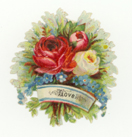The Valentine Lady
by mainelyseo
 Over the centuries, love letters and Valentine cards have added color and spice to mid-winter doldrums. My good friend, Beth Baird knows a lot about antique Valentine cards. She collects and sells them through her business, Elizabeth Baird Ephemera.*
Over the centuries, love letters and Valentine cards have added color and spice to mid-winter doldrums. My good friend, Beth Baird knows a lot about antique Valentine cards. She collects and sells them through her business, Elizabeth Baird Ephemera.*
Beth, when she was as an apprentice to an antiques dealer, fell in love with vintage Valentines. It happened decades ago, one hot August day, while she was helping assess the contents of a summer “camp” (summer home) in Maine. In a lovely heart-shaped candy box, stored in a cedar chest, she found a stack of neatly preserved old letters and Valentines that immediately caught her fancy.
Stories of the creators, the messages, and the art still fascinate her. “Look at the detail in this!” she exclaims pointing out signatures, dates, and tell-tale signs of the history of a handmade card with an original painting. “Printers started printing Valentines in the 1790’s to 1830’s and hand colored them until the 1850’s or 1860’s, then they got fancy with lace and die cuts.”
For decades, Beth has pursued her passion while traveling throughout the US and England, searching for collections of Valentines and other Ephemera. She continues to attend trade shows and auctions. With an outgoing personality and great sense of humor, she also has collected many customers who have become friends and share her affection for Ephemera. She knows which customers want Valentines only with dogs or cats in them, with churches in the background, or ones with lace.
Beth’s collection resides in her three-story Victorian house in Portland’s West End. Thin labeled boxes, stacked on white shelves with spindle posts, keep them organized and protected. All three floors of her house contain not just Valentines, but beautifully designed labels for glass perfume bottles and tin pill boxes, seed packets, and fabric bolt bindings. There are antique prints and posters, specialty books, botanical drawings, playing cards, theater programs, and travel brochures. One whole room is dedicated to children’s books, toys, and paper dolls. The list of categories is too long to list here.
Where there aren’t shelves, the walls are decorated with photos, color lithographs, woodcuts, silk screen prints, original water colors, charcoal portraits, oil paintings, and more. Long drapes in beautiful antique prints and lacy shears grace the 6 foot tall windows of this perfect setting for her collection. A Dalov Ipcar** silk screen print of a cat catches my eye on the curved wall of the staircase.
On the third floor is her studio, where she throws her heart and soul into studying, preserving, and cataloging thousands of pieces of Ephemera. Hallmark Cards, in Kansas City, Kansas, hired her to appraise some early Valentines in their huge collection. Victoria Magazine featured her in a February issue about twenty years ago.
Aside from her expertise as a collector of Ephemera, Beth has a lovely way about her. “I’ve got such exciting things to tell you!” This familiar phrase of hers leads into conversations about art, artists, exhibits, movies, upcoming events, and future plans to attend a lecture, gallery, or film. “I’d really like you to see this exhibit at…” is another familiar expression, often followed by making plans to attend an event.
I met Beth when I took a silk screen workshop at what used to be Westbrook College in Portland, Maine, and she was the teacher. She’s an artist, retired art teacher, and one of the best cooks I have ever been privileged to know.
Beth wrote a cook book, SCRATCHES ON APPLE PIE, illustrated it, hand colored the illustrations, and of course she delved into the history of pies as well. In the book she says, “The ‘pyes’ of old England were baked in a long deep dish called a coffin. ‘Pye recipes’ up to Martha Washington’s day directed colonial cooks to ‘first make your coffin.'”
Check out the apple pie recipe in this month’s newsletter and her “Pie Truisms.” I think pies could definitely be described as Ephemera!
*Ephemera, as defined in many dictionaries, is most often printed material that is designed to be short lived or transitory. It can also refer to plants or insects.
For a more detailed description and information about Ephemera please visit the Ephemera Society of America Web site.
**Dahlov Ipcar (1917-) is an American painter, illustrator and author. She is best known for her colorful, kaleidoscopic-styled paintings featuring animals – primarily in either farm or wild settings. She currently resides in Georgetown, Maine.
Tags: Antique Valentines, collecting Ephemera, collecting Valentines, Elizabeth Baird Ephemera, Ephemera, Valentines Day, vintage Valentines



